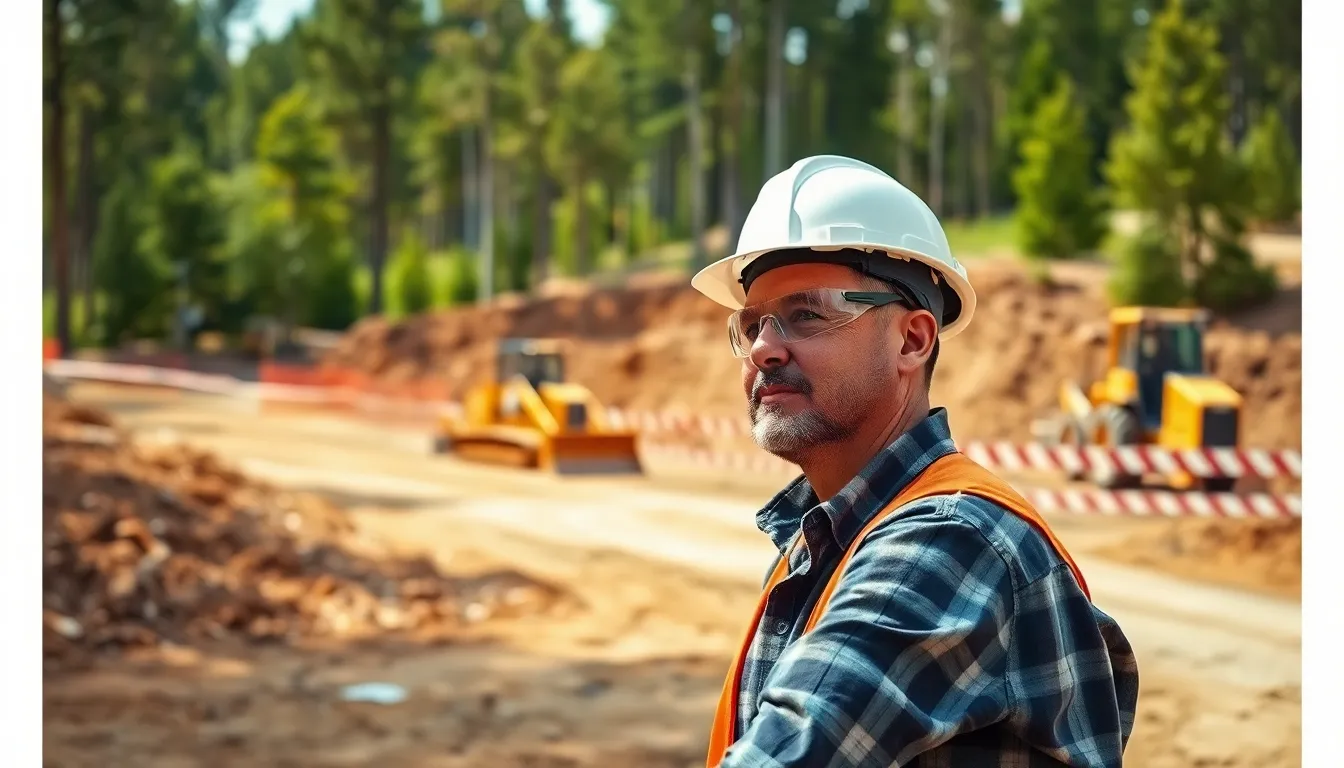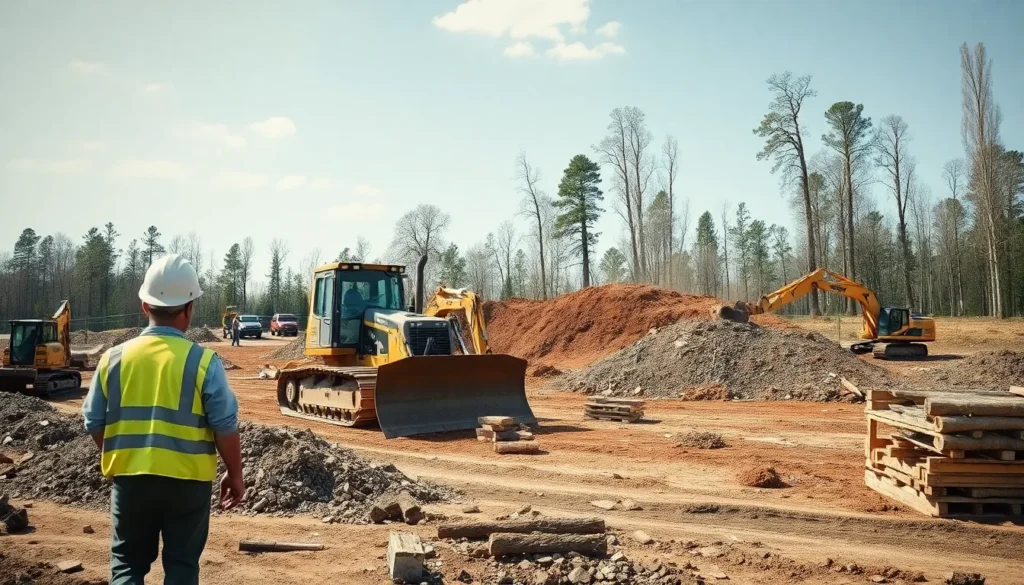When it comes to building a new project, site preparation is the unsung hero of construction. Think of it as the foundation of a great meal—without proper prep, the whole dish can go awry. From clearing debris to leveling ground, every step sets the stage for success. If only it were as easy as saying, “abracadabra,” right?
Table of Contents
ToggleOverview of Building Site Preparation
Building site preparation involves several critical steps that lay the foundation for a successful construction project. Initially, clearing involves the removal of obstacles, such as trees, rocks, and debris. A clean slate allows for better planning and execution.
Next, grading and leveling the ground ensures a stable base for the structure. Leveling involves adjusting the land to the desired elevation. This process often requires heavy machinery for efficiency, especially on larger sites.
Moreover, soil assessment plays a crucial role during preparation. Testing informs decisions regarding compaction, drainage, and suitable building materials. Understanding soil conditions prevents future structural issues.
After grading and soil analysis, utility installation becomes essential. Team members often need to install water, sewage, and electrical lines before further construction. Proper planning at this stage prevents costly rework later.
Additionally, erosion control measures should be implemented to protect the site during construction. These methods, such as silt fences and drainage ditches, minimize soil erosion and protect nearby environments.
Lastly, permits and regulations must be considered throughout the preparation stage. Local authorities may require permits for site clearing, grading, and utility installations. Compliance with these regulations is vital for the project’s success.
Building site preparation combines clearing, grading, soil assessment, utility installation, erosion control, and adherence to regulations. Each step contributes to a solid groundwork for a construction project, ensuring its longevity and success.
Importance of Building Site Preparation

Building site preparation plays a critical role in the success of any construction project. Proper site prep reduces risks and enhances project efficiency.
Safety Considerations
Safety considerations must be top of mind during building site preparation. Clearing the area of debris, trees, and other hazards significantly reduces accidents or injuries for workers. Implementing safety measures, such as proper signage and barriers, keeps unauthorized individuals away. Personal protective equipment should always be used by workers to prevent injuries. Additionally, maintaining clear pathways for equipment and personnel enhances overall safety. Regular inspections of the site also help identify potential hazards before they become critical, further protecting workers and equipment.
Environmental Impact
Building site preparation has a substantial environmental impact that must be addressed. Land clearing disrupts local ecosystems and can lead to habitat loss for wildlife. Implementing erosion control measures, like silt fences and drainage ditches, minimizes soil erosion and water pollution. Assessing the soil before construction informs decisions that promote sustainable building practices. Utilizing native plants for site restoration can further support local ecosystems post-construction. Compliance with environmental regulations ensures projects meet established guidelines, reducing negative effects on the environment and promoting sustainability.
Steps Involved in Building Site Preparation
Building site preparation includes several essential steps that ensure a successful construction project. Enhancing the foundation involves careful consideration and execution of these stages.
Site Assessment
Site assessment involves analyzing the land to identify its characteristics and challenges. Soil quality tests provide crucial information about compaction and drainage. Evaluating terrain features, such as slopes and existing vegetation, plays a role in planning the construction’s structural integrity. Assessments also address environmental concerns, ensuring compliance with local regulations. Collecting this data creates a foundation for informed decisions throughout the project.
Clearing and Grubbing
Clearing and grubbing involves removing obstacles to create a clean construction site. This process includes the elimination of trees, brush, rocks, and debris. Specialized equipment, such as bulldozers and excavators, makes this task more efficient. Grubbing goes a step further by stripping away roots and organic matter. Ensuring a thorough clean-up lays the groundwork for subsequent construction stages.
Excavation and Grading
Excavation and grading reshape the terrain, preparing a stable foundation for structures. Excavation removes excess soil to create trenches, basements, or foundations. Grading evenens out surfaces, making them suitable for construction activities. Heavy machinery often facilitates these tasks, increasing efficiency and precision. Achieving the right grade also promotes effective drainage, reducing future water-related issues.
Equipment Used in Site Preparation
Proper equipment is vital for effective site preparation, with both heavy machinery and hand tools playing essential roles.
Heavy Machinery
Excavators, bulldozers, and graders dominate the heavy machinery category. These powerful machines handle large-scale tasks, from clearing debris to grading and leveling ground. Excavators excel in digging trenches and moving earth, while bulldozers push materials across the site, creating a smooth and stable surface. Graders fine-tune the surface, ensuring proper slope for drainage. This machinery enhances efficiency, significantly speeding up the preparation process. These vehicles are designed to tackle various terrains, making them indispensable on construction sites.
Hand Tools
Hand tools also play a crucial role in fine-tuning site preparation tasks. Shovels, rakes, and pickaxes help workers complete intricate work around smaller areas. Shovels move soil and debris efficiently, while rakes level and spread materials evenly. Pickaxes break up hard ground, making it easier to prepare the site for further processes. These tools allow for precision where heavy machinery may be too cumbersome. Equipped with hand tools, workers can address the finer details ensuring a well-prepared site for construction.
Best Practices for Efficient Site Preparation
Effective site preparation relies on several best practices that ensure a smooth construction process. Prioritizing a detailed site assessment lays the groundwork for all subsequent steps. This assessment includes analyzing soil type, slope, and existing drainage patterns, providing crucial information for planning.
Clearing and grubbing come next, involving the removal of vegetation, debris, and obstacles. Utilizing heavy machinery for this task enhances efficiency, allowing rapid progress toward a clean site. Simultaneously, thorough leveling creates a stable foundation essential for structural integrity.
Maintaining proper drainage throughout the site minimizes the risk of water accumulation that could compromise the project. Implementing silt fences and drainage ditches serves to prevent erosion during construction. Regularly inspecting these measures ensures their effectiveness and adherence to environmental regulations.
Utility installation must follow site preparation to facilitate infrastructure. Prior planning prevents potential conflicts with buried utilities during construction. Installing water, sewage, and electrical lines early on sets the stage for efficient project execution.
Communication within the construction team remains vital. Ensuring all members understand the site layout and safety protocols reduces hazards and fosters a collaborative environment. Utilizing personal protective equipment aligns with safety standards, creating a safer workspace.
Fostering sustainability during site preparation also plays a critical role. Implementing eco-friendly practices minimizes the environmental impact, aligning with regional regulations. Following these best practices leads to efficient site preparation, setting the stage for a successful construction project while prioritizing safety and sustainability.
Building site preparation is a vital phase in any construction project. It sets the stage for success by ensuring a stable foundation and adhering to safety and environmental standards. Each step from clearing and grading to utility installation plays a crucial role in minimizing future risks and enhancing efficiency.
By prioritizing proper planning and utilizing the right equipment, teams can streamline the process and avoid costly setbacks. Emphasizing sustainability and compliance with regulations not only protects local ecosystems but also contributes to the project’s overall success. Investing time and resources in thorough site preparation ultimately pays off, leading to a more durable and effective construction outcome.





